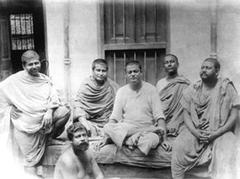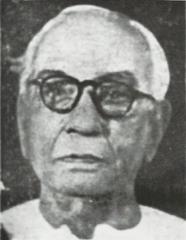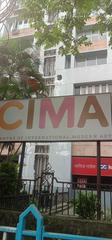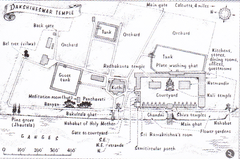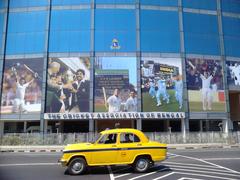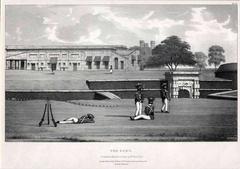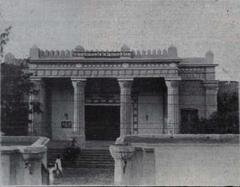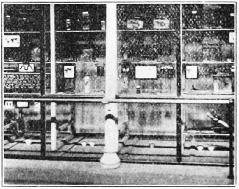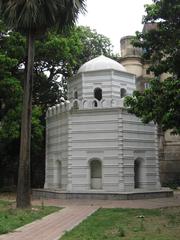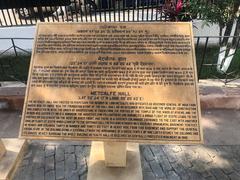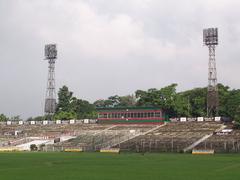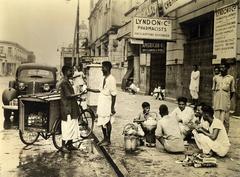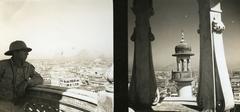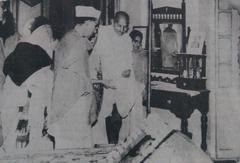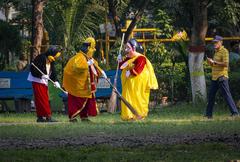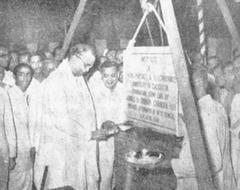Dayamoyee Kalibari Kolkata: Visiting Hours, Tickets, and Complete Guide
Date of Publication: 14/06/2025
Introduction
Dayamoyee Kalibari, also known as Lake Kalibari, is a revered Hindu temple in Kolkata, India, dedicated to Goddess Kali in her compassionate form as Dayamoyee. While often overshadowed by the more famous Kalighat and Dakshineswar temples, Dayamoyee Kalibari offers an intimate spiritual experience deeply rooted in Bengal’s religious and cultural renaissance. Its traditional Bengali architecture, vibrant festivals, and role as a community hub make it a significant destination for both devotees and travelers.
This comprehensive guide provides in-depth information on the temple’s history, architecture, religious practices, visiting hours, accessibility, nearby attractions, and practical tips—ensuring you have all you need for a meaningful visit.
Historical Background and Evolution
Origins and Cultural Context
Dayamoyee Kalibari was established in the late 19th or early 20th century, during a period of urban expansion and spiritual revival in Kolkata. The city itself is believed to derive its name from “Kalikshetra” (land of Kali), underscoring the goddess’s pivotal role in local identity (Testbook). The temple’s founding responded to a growing need among Kolkata’s residents for neighborhood shrines during the Bengal Renaissance, a time marked by renewed interest in indigenous religious and cultural traditions (Sociology Institute).
Evolution Through Colonial and Modern Eras
Under British rule, Kolkata’s rapid growth led to the proliferation of temples like Dayamoyee Kalibari, often supported by wealthy patrons. Post-independence, the temple expanded its social functions, offering charitable services, educational support, and community events—mirroring the city’s transformation into a modern metropolis.
Architectural Features
Temple Design
Dayamoyee Kalibari exemplifies traditional Bengali temple architecture, particularly the Aat Chala style, with a double-tiered, sloping roof and terracotta ornamentation (Inditales). The garbhagriha (sanctum sanctorum) houses a clay idol of Goddess Kali, repainted annually. The temple’s intimate layout fosters a close connection between devotees and deity.
Auxiliary Structures
A spacious courtyard, shaded by ancient trees, provides space for congregational worship and festivals. Additional shrines dedicated to Shiva, Lakshmi, and Saraswati reflect the inclusive nature of Bengali spiritual practice. The natmandir (prayer hall) hosts devotional music and community gatherings, especially during major festivals (Caleidoscope).
Artistic Heritage
Temple interiors and exteriors feature Kalighat-style murals and paintings, with bold colors and mythological motifs. These artistic elements deepen the cultural experience for visitors (Inditales).
Religious and Cultural Significance
Worship and Rituals
Dayamoyee Kalibari is a focal point for daily worship, with morning and evening aarti, recitations, and offerings of flowers, sweets, and fruits. The compassionate form of Kali as Dayamoyee is especially venerated here, and the temple is alive with activity during Kali Puja and Amavasya (new moon) nights (Holidays Hunt, roamingverse.com).
Festivals and Cultural Events
Kali Puja is the highlight of the temple’s calendar, featuring elaborate rituals, night-long worship, music, and community feasts. Durga Puja and other traditional festivals also see special observances, drawing large crowds and fostering a festive community spirit (traveltriangle.com).
Community and Social Role
Beyond religious functions, Dayamoyee Kalibari is deeply involved in social welfare, such as food distribution, educational support, and medical aid, reflecting the compassionate ideals of the goddess (getbengal.com).
Visiting Information
Visiting Hours
- General Hours: 5:00 AM – 10:00 PM daily.
- Peak Times: Early mornings and evenings, especially during festivals.
- Midday Closure (some sources): 2:00 PM – 5:00 PM for the goddess’s rest (Inditales).
- Aarti Timings: Scheduled in the mornings and evenings.
Entry and Tickets
- Entry Fee: Free for all visitors.
- VIP Darshan: Available for a nominal fee, offering expedited entry during busy times.
Accessibility
- Public Transport: Easily accessible via buses, metro, and taxis; the nearest metro station is within walking distance.
- Facilities: Ramps and pathways are provided, but some areas may have limited accessibility due to traditional architecture. Wheelchair assistance may be needed (Inditales).
- Amenities: Drinking water, washrooms, shaded waiting areas.
Travel Tips
- Dress modestly and remove footwear before entering the temple.
- Seek permission for photography, especially inside the sanctum.
- Plan visits early in the day or late evening to avoid crowds, particularly during festivals.
- Be cautious during the monsoon season, as approach roads may become waterlogged.
Nearby Attractions
Dayamoyee Kalibari is well-placed for exploring Kolkata’s rich religious and cultural landscape. Notable nearby sites include:
- Dakshineswar Kali Temple: Grand riverside temple and major pilgrimage center.
- Kalighat Kali Temple: One of the 51 Shakti Peethas, renowned for its vibrant worship.
- Belur Math: Headquarters of the Ramakrishna Mission.
- Victoria Memorial: Iconic colonial-era monument.
- Indian Museum: India’s oldest museum.
- Jorasanko Thakurbari: Home of Rabindranath Tagore.
- Local markets: Experience traditional crafts and Bengali cuisine.
For travelers interested in broader excursions, destinations like Mayapur, Santiniketan, and the Sundarbans are accessible from Kolkata.
Rituals, Festivals, and Cultural Practices
Daily worship at Dayamoyee Kalibari is conducted by traditional priests, maintaining strict adherence to Bengali customs. Rituals include lamp offerings, mantra recitation, and the distribution of prasad (sanctified food). Major festivals such as Kali Puja and Durga Puja are celebrated with cultural performances, devotional singing, and elaborate decorations (Holidays Hunt).
Visitor Experience
What to Expect
- Atmosphere: Serene and welcoming, with a blend of spiritual devotion and community warmth.
- Crowd Levels: Moderate on weekdays, high during festivals and special aarti times.
- Cultural Activities: Experience music, dance, and local artisans’ stalls during festivals.
- Local Food: Enjoy traditional Bengali snacks at nearby eateries.
Etiquette
- Dress conservatively; covering your head and shoulders is considered respectful.
- Remove shoes before entering temple grounds.
- Follow staff instructions and respect local customs.
Frequently Asked Questions (FAQ)
Q1: What are the visiting hours of Dayamoyee Kalibari?
A1: The temple is open daily from 5:00 AM to 10:00 PM, with a possible midday closure from 2:00 PM to 5:00 PM.
Q2: Is there an entry fee or ticket required?
A2: Entry is free. A VIP darshan line is available for a nominal fee.
Q3: How can I reach the temple?
A3: Use Kolkata’s public transport network—buses, metro, or taxis. The nearest metro station is within walking distance.
Q4: Are there facilities for differently-abled visitors?
A4: There are some accessible pathways, but assistance may be needed due to steps and uneven surfaces.
Q5: Can I take photographs inside?
A5: Photography is allowed in the courtyard and exterior; permission is required for interior spaces.
Visuals and Media
High-quality photographs, virtual tours, and maps are available on the temple’s official website and cultural heritage portals. When sharing images, use descriptive alt text such as “Dayamoyee Kalibari temple facade” or “Kali Puja celebrations at Dayamoyee Kalibari” for accessibility and SEO.
Summary and Visitor Tips
Dayamoyee Kalibari embodies Kolkata’s spiritual richness and compassionate community ethos. Its architecture, festivals, and social outreach set it apart as a must-visit destination for devotees and travelers alike. With generous visiting hours, free entry, and proximity to major attractions, the temple is accessible and rewarding.
Visitor Tips:
- Visit early or late to avoid crowds.
- Dress appropriately and respect customs.
- Explore nearby cultural sites for a comprehensive Kolkata experience.
- Check official resources for festival dates and special events.
Call to Action
Plan your visit to Dayamoyee Kalibari and immerse yourself in one of Kolkata’s most cherished spiritual sanctuaries. For guided tours, festival updates, and more travel tips, download the Audiala app and follow us on social media. Share your experiences with #DayamoyeeKalibariVisit and become part of Kolkata’s vibrant spiritual story.
Sources and Further Reading
- Dayamoyee Kalibari Kolkata: History, Visiting Hours, Tickets & Travel Tips, Testbook
- Dayamoyee Kalibari Kolkata: Visiting Hours, Tickets, and Cultural Significance, hinduvism.com
- Dayamoyee Kalibari: Visiting Hours, Tickets, and Complete Guide to Kolkata’s Historic Kali Temple, Inditales
- Visiting Dayamoyee Kalibari: Hours, Tickets & Nearby Attractions in Kolkata, Traveltriangle
- Dayamoyee Kalibari Kolkata: History, Visiting Hours, Tickets & Travel Tips, Sociology Institute
- Dayamoyee Kalibari Kolkata: History, Visiting Hours, Tickets & Travel Tips, Holidays Hunt
